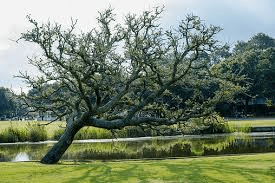Root rot is a serious condition in trees, often caused by waterlogged soil, poor drainage, or specific fungi that attack the roots. Recognizing the signs of root rot early can help you take steps to save the tree or prevent the spread to other plants. Here are some of the main signs of root rot in trees and tips on what to look for:
1. Wilting and Discolored Leaves

- Yellowing or Browning Leaves: One of the earliest signs of root rot is when leaves begin to yellow, wilt, or turn brown despite adequate watering.
- Premature Leaf Drop: Infected trees may shed leaves early in the growing season. This is often a response to the reduced ability of the roots to transport nutrients and water.
2. Reduced Growth and Stunted Size

- Slow or Stunted Growth: Trees affected by root rot will often show significantly slower growth than healthy trees. You might notice that new leaves or shoots are smaller and fewer in number.
- Sparse Foliage: Root rot limits nutrient absorption, causing sparse or patchy foliage. This is especially noticeable if the tree once had thick, lush growth.
3. Soft, Mushy, or Decayed Roots

- Rotten or Slimy Roots: If you can carefully inspect the roots, healthy ones are firm and white. Rot-affected roots appear brown or black, feel mushy or slimy, and may have an unpleasant odor.
- Breaking Roots: Rotted roots often become fragile and break easily, while healthy roots are strong and flexible.
4. Fungal Growth at the Base of the Tree

- Mushrooms or Fungus: Mushrooms or fungal growth around the base of the tree or on exposed roots are clear indicators of root rot. Fungi thrive on decaying organic matter and can signal a problem with the roots.
- White, Black, or Dark Stains: If you notice discolorations or fungal mats at the tree’s base, this often indicates a fungal infection that has spread to the root zone.
5. Darkened or Soft Bark at the Tree Base

- Discolored Bark: Root rot can cause the bark at the base of the trunk to turn dark, become soft, or even ooze liquid. This indicates that the infection may have spread from the roots up through the tree.
- Peeling or Loose Bark: As the infection progresses, the bark may start to peel away from the tree trunk, and portions may feel loose to the touch.
6. Leaning or Unstable Tree Structure

- Wobbly or Leaning Tree: Root rot weakens the tree’s anchorage in the soil, and you may notice the tree leaning or becoming less stable over time.
- Exposed Roots: As roots rot and die, they lose their ability to anchor the tree securely, causing it to shift in the soil, especially in wind or rain.
7. Dieback in Branches and Crown

- Bare Branches: Branch dieback, particularly in the upper parts of the tree (crown), is a strong sign that the roots are struggling to supply nutrients.
- Dead or Weak Branches: Affected trees may develop weak, brittle branches that die back prematurely, which can indicate root issues impacting the overall health of the tree.
8. Soil that is Constantly Wet or Has Poor Drainage

- Waterlogged Soil: Excess moisture around the base of the tree, either from poor drainage or over-watering, can suffocate roots and make them susceptible to fungal infections.
- Poor Drainage Indicators: If the soil stays wet long after rain or irrigation, it might be a sign of poor drainage, which creates ideal conditions for root rot pathogens.
What to Do if You Suspect Root Rot
- Improve Drainage: Reduce the watering frequency and consider improving soil drainage, especially if the tree is in a low-lying area.
- Aerate the Soil: Aerating around the base of the tree can help oxygen reach the roots and dry out the soil.
- Apply Fungicides: Some fungicides can treat specific types of root rot fungi, though they may not cure severe cases. Consult an arborist for safe application.
- Prune Infected Branches: Removing infected branches can help the tree focus its energy on recovering. Be sure to sanitize tools afterward to prevent spreading fungi.
Identifying root rot early is essential for addressing it before it becomes too severe. If you’re concerned about root rot, consulting an arborist is a good step to properly diagnose the issue and determine the best course of action.


